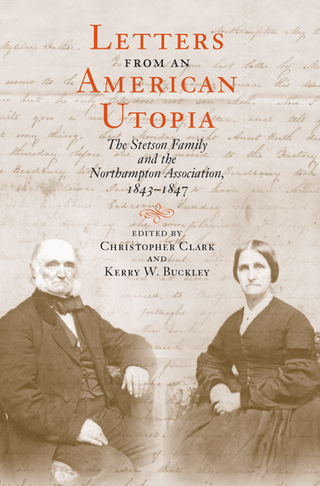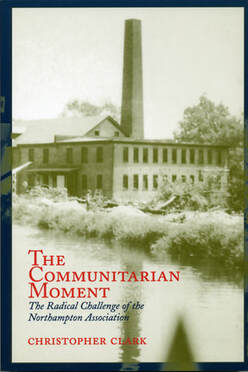Life in Florence's Utopian Community, 1843-1846: The Stetson Family Letters
A Zoom Presentation by Dr. Christopher Clark, Emeritus Professor of History, University of Connecticut
With Readings from the Stetson Family Letters by Mary Beth Brooker, Tahmie Der & Tom Goldscheider
A Zoom Presentation by Dr. Christopher Clark, Emeritus Professor of History, University of Connecticut
With Readings from the Stetson Family Letters by Mary Beth Brooker, Tahmie Der & Tom Goldscheider
Thursday, April 27, 2023 at 7 pm
|
Join us as the Stetson family comes to life through their letters.
Historian Christopher Clark will discuss the Stetson family letters (now at Historic Northampton) written while they were members of the Northampton Association of Education and Industry. Selected excerpts from the letters will be read by Mary Beth Brooker as Dolly (the mother), Tahmie Der as Almira (the teenaged daughter), and Tom Goldscheider as James (the father). The Stetson family came to Florence in 1843 -- 180 years ago -- to join the Northampton Association of Education and Industry. They wanted to live and work with people who shared their values of immediate emancipation of slavery and equal rights for all "without distinction of sex, color or condition, sect or religion.” The letters provide a close look at a single family before, during, and after their membership in an abolitionist, utopian community. Glimpses of Sojourner Truth, David Ruggles, and other leading figures of the community appear throughout the correspondence. |
Christopher Clark will speak on Zoom
on Thursday, April 27, 2023 at 7 pm. |
|
Historian Tom Goldscheider will read from letters written by James Stetson (1801-1893), the husband and father who served as the community's silk agent on the road and in Boston.
"... the welfare of our children will always be uppermost in our minds & I am greatly mistaken if here is not the best place for them that we can ... expect to get, if they can but carry out the plan they propose in their different Schools ..." James A. Stetson to Dolly W. Stetson, [February 20, 1843] |
Performer and writer Mary Beth Brooker will read from the letters of Dolly Witter Stetson (1807-1899), the wife and mother remembered for her superior intelligence.
"I think I can look back to my past life and see where I may have been saved from what might have been far worse by a game of whist – and I had much rather my daughters should be dancing or playing cards (as wicked as that sounds, in a mixed company of boys and girls than in the language of Sojourner [Truth] to be lolling on each other squeezing each others hands or sitting in each others laps …" Dolly W. Stetson to James A. Stetson, October 6, 1844 |
Actor Tahmie Der will read from letters written by Almira Stetson (born May 22, 1828), the eldest child who worked in the cocoonery and attended school.
“Now Dear Father I intended to have written by this box a good long letter to you .... But I cannot, for last night Dr. [Sylvester] Graham lectured in town against 'Odd Fellowship' ... so I thought I would go ... Graham out did himself.” Almira Stetson to James A. Stetson, [June 27, 1845] |
For Further Reading
|
Letters from an American Utopia: The Stetson Family and the Northampton Association, 1843-1847 edited by Christopher Clark and Kerry W. Buckley
(University of Massachusetts Press, 2004). The Stetson Family Correspondence was donated to Historic Northampton in 2000 by six descendants of the Stetson family. In 2004, transcriptions of the letters were published in this book with interpretive essays by Christopher Clark, Marjorie Senechal and Paul Gaffney. The letters provide insights into a single family's experience of living in an American utopian community and into the role of women in particular. In 2017, the book was reprinted in paperback by Levellers Press of Amherst, MA and is available for sale at www.levellerspress.com or at the Historic Northampton Museum Store ($20). The letters are part of an Emerging America educational website, Radical Equality: the Northampton Association of Education and Industry. |
|
The Communitarian Moment: The Radical Challenge of the Northampton Association by Christopher Clark (Ithaca, N.Y.: Cornell University Press, 1995.)
In 1842, a group of silk manufacturers, farmers and abolitionists established a community in Broughton's Meadow (now Florence, Massachusetts) called the Northampton Association of Education and Industry. Several of its founders had purchased the land, factory and machinery of the bankrupt Northampton Silk Company at a 470 acre site along the Mill River. The association aimed to communally raise silkworms and produce silk thread. The four-story brick factory contained a silk cocoonery, a communal dining room and a community boardinghouse. Over the four and a half years of its existence, at least 240 men, women and children lived at the community, although at any one time, the size never exceeded 120 residents. The book was based upon newly rediscovered official records of the organization at the American Antiquarian Society in Worcester, MA. In 2003, it was reprinted in paperback by the University of Massachusetts Press. |
Christopher Clark is an emeritus professor of History at the University of Connecticut. He obtained his PhD in History at Harvard University. He taught at the University of York and at the University of Warwick before moving to UConn in 2005. In addition to his books on the Northampton Association, he is also the author of Social Change in America from the Revolution to the Civil War (Chicago: Ivan R. Dee, 2006), The Roots of Rural Capitalism: Western Massachusetts, 1780-1860 (Ithaca, N.Y.: Cornell University Press, 1990) and numerous articles.
Header Image:
Letter, Almira Stetson to James Stetson, Northampton, March 4, 1845. (Letter no. 42, Letters from an American Utopia: The Stetson Family and the Northampton Association, 1843-1847, edited by Christopher Clark and Kerry W. Buckley, pp. 91-92.)
"I have form ... necessity for a while past given up all hopes of pursuing such a course of study, but I have been reading and hearing a good deal within a few days of Margret Fuller the author of "Woman in the Nineteenth century," (which is a very superior work) She is an almost entirely a self educated woman, her father was once a wealthy man but failed in business and being honest he gave up almost every thing, but Margret was very ambitious and she went on with her education alone, and it is the opinion of all who are acquainted with her that she is very superior woman.... I do not expect to come up to her however in talents but I can do my best for it...
I want a good education and I think I can have it by improving every moment.... My plan is this, and I go to Mr Mack for his opinion of the authors and works. The following ... are the branches A thourough course of ancient and modern History. Latin. Phylosophy Astronomy Chemistry. Algebra - Geometry. Physiologs and Botany. Geography as ... distinct from history I think I have a pretty good knowledge of. Grammar I am going through with now minutely. These are the principle ones, there are others which would come in incidentally."
Letter, Almira Stetson to James Stetson, Northampton, March 4, 1845. (Letter no. 42, Letters from an American Utopia: The Stetson Family and the Northampton Association, 1843-1847, edited by Christopher Clark and Kerry W. Buckley, pp. 91-92.)
"I have form ... necessity for a while past given up all hopes of pursuing such a course of study, but I have been reading and hearing a good deal within a few days of Margret Fuller the author of "Woman in the Nineteenth century," (which is a very superior work) She is an almost entirely a self educated woman, her father was once a wealthy man but failed in business and being honest he gave up almost every thing, but Margret was very ambitious and she went on with her education alone, and it is the opinion of all who are acquainted with her that she is very superior woman.... I do not expect to come up to her however in talents but I can do my best for it...
I want a good education and I think I can have it by improving every moment.... My plan is this, and I go to Mr Mack for his opinion of the authors and works. The following ... are the branches A thourough course of ancient and modern History. Latin. Phylosophy Astronomy Chemistry. Algebra - Geometry. Physiologs and Botany. Geography as ... distinct from history I think I have a pretty good knowledge of. Grammar I am going through with now minutely. These are the principle ones, there are others which would come in incidentally."





